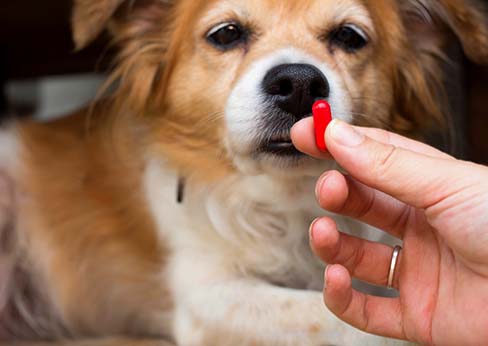In this post:
- How can I make my dog take his medicine?
- How to give dog medications down the throat?
- How to give a dog ear medication?
- 5 Fun Facts About Your Dog’s Ears
Did your dog just get medication from your vet? Many times, this can be a daily struggle trying to get your dog to take medications. Some dogs will easily and quickly eat anything that you give them while others will spit out the pill and put up a fight. There are many tips and tricks on how to give your dog medication.
How can I make my dog take his medicine?
Dogs are no more fond of the taste of their medicine than most humans. Unfortunately for us, this means that we may have to get creative in encouraging them to take their medicine. One popular product to help your dog take his medicine is a pill pocket. You can buy pill pockets at most pet stores.
If you don’t have any pill pockets on hand there are other things in your fridge that may work. Some people may use bits of hot dogs. You just shove the pill into the center and toss it to your pet. You can also try to wrap the pill in super-soft cheese or use boiled pasta. The pasta with hallow center big enough to put a pill into is the best choice. Make sure that whatever food your using is safe for dogs and will not cause them harm.
If all fails, watch our video on how to give a pill by putting it in the dog’s mouth.
How to give dog medications down the throat?
While some dogs will eat medicine right from your hands or their food bowl others are masters at avoiding the pills at all costs. Before trying to give the pill by putting it into the back of the mouth, always try methods mentioned above that are not as invasive for your dog.
- Make sure your dog is comfy and relaxed. Hold the pill in one hand.
- With your other hand, gently hold the muzzle with your thumb on one side and your fingers on the other. Gently squeeze until the mouth is open.
- Tilt the head back and drop the pill into the back of the throat. Close the mouth and keep holding it closed.
- Rub the throat to encourage swallowing.
- Praise and reward your dog after. Giving a pill by putting it into the dog’s mouth can be a hard experience for you and your dog. Make sure to reward and praise him during and after the ordeal.
- If he spits the pill out, you might have to try again.
Try to keep your voice and yourself calm and relaxed. You want to try to make this as good of an experience as possible! Even with this trick your dog may be able to find a way to spit the pill out. If you are having trouble giving your dog medication, ask your vet for help. Many times, they can show you how to easily give your dog medication at home.
How to give a dog ear medication?
Not all medication that you have to give your dog goes in their mouth. Your dog may have an ear infection and need medication put in your dog’s ears. Before beginning, make sure your dog is comfortable and relaxed.
- Flip the ear over. You might need to hold his head at the same time.
- With your free hand administer the medication into the ear.
- Flip the ear back and massage it to get meds into the ear canal. Your dog will shake his head when you are done, so step back.
- Make sure to praise and reward your dog.
Ask your vet how many meds you need to give. ALWAYS seek medical attention for your dog if you suspect an ear infection. Your vet will be able to diagnose the problem and provide appropriate medication and preventative measures for you to follow.
5 Fun Facts About Your Dog’s Ears
We all like to claim ourselves as dog lovers and we may know a lot about taking care of them and providing a loving environment, but how much do you know about their ears? So, here are 5 fun facts you may have never known or even considered thinking about when it comes to your dogs and their ears.
Puppies are born deaf. For the first couple of weeks, their ear canals are closed off and they can’t hear anything.
Are you ever wondering if your dog is paying attention? You can tell by their ears! When a dog is engaged, they have erect ears that are facing forward.
Dogs can hear EVERYTHING… they have the ability to pick up high-frequency pulses (which could even be vibrations of bugs in the walls).
Depending on the breed, dogs have about 18 ear muscles. Humans only have 3, which explains why dogs can rotate, tilt, raise, and lower their ears.
According to Nationwide Pet Insurance, the number one reason owners took their dogs to the vet in 2016 resulted from ear infections.
When it comes to dogs, we consider them family. Make it a part of your weekly routine to care for your dog’s ears, they are such a vital part of their anatomy and health! Ear care is not always something we think of doing when it comes to our dogs, but it is so important. Regular and proper ear cleaning for your furry friends will save you an extra trip to the vet during a busy and stressful week.
Final Thoughts
Giving your dog medication can seem like a daunting task, but following these recommendations, your dog can quickly and easily learn to love to take their medication. Most dogs do not mind medication when it included a tasty treat.





